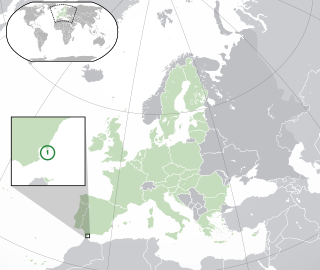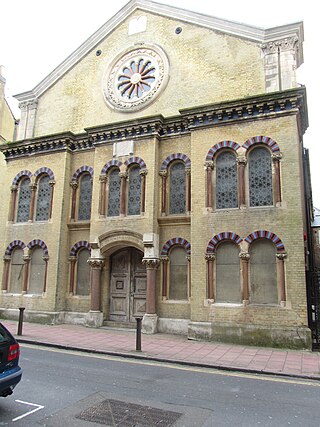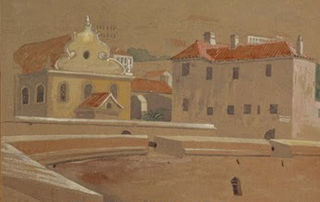Related Research Articles

Cochin Jews are the oldest group of Jews in India, with roots that are claimed to date back to the time of King Solomon. The Cochin Jews settled in the Kingdom of Cochin in South India, now part of the state of Kerala. As early as the 12th century, mention is made of the Jews in southern India by Benjamin of Tudela. They are known to have developed Judeo-Malayalam, a dialect of Malayalam language.

Bevis Marks Synagogue, officially Qahal Kadosh Sha'ar ha-Shamayim, is the oldest synagogue in the United Kingdom in continuous use. It is located off Bevis Marks, Aldgate, in the City of London.

The Great Synagogue of London was, for centuries, the centre of Ashkenazi synagogue and Jewish life in London. Built north of Aldgate in the 17th century, it was destroyed during World War II, in the Blitz.
Ernest Martin Joseph, OBE, architect and youth worker. He was a leading designer of synagogues, including the Art Deco synagogue at Sheepcote Street, Birmingham, and the classically styled synagogue in St. John's Wood Road, London. He was also a partner in the firm of Messrs Joseph, whose best known building is Shell Mex House between the Strand and the Thames Embankment in London. He was one of six children of Nathan Solomon Joseph (1834–1909), also an architect and social worker, and his wife Alice who died in his infancy. N. S. Joseph was brother-in-law to the chief rabbi, Hermann Adler.

Colonel Albert Edward Williamson Goldsmid was a British officer. He was the founder of the Jewish Lads' Brigade and the Maccabaeans.

The Great Synagogue of Gibraltar, also known as Kahal Kadosh Sha'ar HaShamayim, is located in the British overseas territory of Gibraltar, and was the first synagogue on the Iberian Peninsula to operate since the expulsions from Spain and Portugal in 1492 and 1497 respectively.

The history of the Jews in Gibraltar dates back more than 650 years. There have been periods of persecution, but for the most part the Jews of Gibraltar have prospered and been one of the largest religious minorities in the city, where they have made contributions to the culture, defence, and Government of Gibraltar.

The New West End Synagogue, located in St. Petersburgh Place, Bayswater, London, is one of the oldest synagogues in the United Kingdom still in use. It is one of two synagogues which have been awarded Grade I listed building status by Historic England, which has described it as “the architectural high-water mark of Anglo-Jewish architecture”. It can accommodate approximately 800 people.

The Middle Street Synagogue is a synagogue in the centre of Brighton, part of the English city of Brighton and Hove. It was the centre for Jewish worship in Brighton and Hove for more than a century. Although it is not in full-time use, the building is still open at certain times, and cultural events frequently take place, as do weddings. It has been listed at Grade II*, reflecting its architectural and historic importance.

Nathan Solomon Joseph was an English philanthropist, social reformer, architect, and Jewish communal leader.

The Cheltenham Synagogue is a synagogue in Cheltenham noted for its Regency architecture. It is an independent congregation located in the town centre on Synagogue Lane, off St James's Square.

The Plymouth Synagogue is a synagogue in the city of Plymouth, England and the home of the Plymouth Hebrew Congregation. Built in 1762, it is a listed Grade II* building and the oldest extant synagogue built by Ashkenazi Jews in the English speaking world.

Sandy's Row Synagogue is a historic Grade II listed synagogue and former Christian church in the East End of London. Built by refugee French Huguenots in 1766, it was later converted into a Baptist chapel and in 1867 was acquired by a Jewish congregation. It is the oldest surviving Ashkenazi synagogue in London.

The former Merthyr Synagogue is located on Bryntirion Road in the Thomastown section of Merthyr Tydfil, Wales. It is a Grade II listed building and is the oldest purpose-built synagogue still standing in Wales.

The Roof-top synagogue was a private synagogue built on the roof of the home of Philip Salomons on the Regency-era Brunswick estate in Hove, now a constituent part of the English city of Brighton and Hove. It is a small octagonal edifice on the top of a glass room forming part of the fourth floor, in reference to the Dome of the Rock in Jerusalem.

The four active synagogues of Gibraltar are colloquially known as the Great Synagogue, the Little Synagogue, the Flemish Synagogue, and the Abudarham Synagogue. The first synagogue established after the 1717 expulsion of Jews from Gibraltar, the Great Synagogue, was built on what is now known as Engineer Lane, and remains Gibraltar's principal synagogue. The Little Synagogue, founded in 1759 in Irish Town, was the result of the desire of Moroccan Jews for a less formal service. The lavish Flemish Synagogue was built at the turn of the nineteenth century on Line Wall Road, due to the request of some congregants for a return to more formal, Dutch customs. The last synagogue to be established in what is now the British overseas territory of Gibraltar, the Abudarham Synagogue, was founded in 1820 on Parliament Lane by recent Moroccan immigrants.

Kingston upon Hull, on England's East Coast was, by 1750, a major point of entry into Britain for traders and migrants, second only to London for links to the continent. Around then, a few Jews from German and Dutch cities lodged and settled in Hull. Selling jewelry and dealing goods in the thriving port and market town, they maintained contacts with Europe, London, and many other – particularly Northern – towns. The small community produced its own institutions and leaders, which were tested by anti-Jewish sentiment, and later by an influx of East-European refugees.
References
- ↑ "sharmankadish.com". sharmankadish.com. Retrieved 21 March 2019.